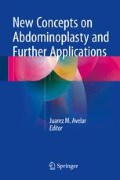Abstract
Aesthetic appearance of the abdomen has a great variable form.
An abdomen within the beauty standards has a “lyre” form, due to light reflections on prominences and shadows on the sulcus.
The final result to achieve the ideal shape is directly proportional to the preoperative situation; the greater the deformity, the minor the possibility to achieve the ideal shape.
Treatment of the external oblique muscle diastasis is a technique to be used in many cases, as simple plication or complete dissection and medial advancement of the muscles, to reduce the waist and for an overall better remodeling of the abdomen.
Access this chapter
Tax calculation will be finalised at checkout
Purchases are for personal use only
References
Psillakis JM et al (1991) Color atlas of aesthetic surgery of the abdomen. Thieme Medical Publishers, Inc, New York, pp 1–88
Bozola AR, Psillakis JM (1988) Abdominoplasty: a new concept and classification for treatment. Plast Reconstr Surg 82:983–993
Callia WE (1965) Contributions for the surgical correction of the pendulous and globose abdomen: original technique. Doctor’ s thesis, Medicine Medical School, São Paulo University, Sao Paulo
Callia WE (1967) A plastic surgery technique for the general surgeon. Med Hosp 1:40–52
Pitanguy I (1967) Abdominal lipectomy: an approach to it through an analysis of 300 consecutive cases. Plast Reconstr Surg 40:384–391
Psillakis JM et al (1991) Color atlas of aesthetic surgery of the abdomen. Thieme Medical Publishers, Inc, New York, pp 43–45
Psillakis JM (1978) Abdominoplasty: some ideas to improve results. Aesthetic Plast Surg 2:205–215
Psillakis JM (1984) Plastic surgery of the abdomen with improvement in the body contour. Clin Plast Surg 11(3):465–477
Psillakis JM (1984) Abdominoplasty: treatment of the external oblique muscle to obtain a better waist. Ann J Sul Bras Plast Surg SBCP 1:85–89
Avelar JM (2000) Abdominoplasty: a new technique without undermining and fat layer removal. Arq Catarin Med 29:147–149
Saldanha OR, De Souza Pinto EB, Mattos WN Jr, Pazetti CE, Lopes Bello EM, Rojas Y et al (2003) Lipoabdominoplasty with selective and safe undermining. Aesthetic Plast Surg 27(4):322–327
Avelar JM (1978) Abdominoplasty: systematization of a technique without external umbilical scar. Aesthetic Plast Surg 2:141–151
Saldanha OR (2001) Lipoabdominoplasty without undermining. Aesthet Surg J 21:518–526
Avelar JM (2002) Abdominoplasty without panniculus undermining and resection: analysis and 3-year follow-up of 97 consecutive cases. Aesthet Surg J 22:16
Kirianoff TG (1978) Making a new umbilicus when none exists. Plast Reconstr Surg 61(4):603–604
Amud RJM (2008) Neo-onfaloplastia sem cicatriz. Rev Bras Cir Plast 23(1):37–40
Abreu JA (2010) Abdominoplasty: neoomphaloplasty without scar or fat excision. Rev Bras Cir Plást 25:499–503
Psillakis JM et al (1991) Color atlas of aesthetic surgery of the abdomen. Thieme Medical Publishers, Inc, New York, pp 76–81
Grazer FM, Goldwyn RM (1977) Abdominoplasty assessed by the survey, with emphasis on complications. Plast Reconstr Surg 59(4):513–517
Teimourian B, Rogers WB 3rd (1989) A national survey of complications associated with suction lipectomy: a comparative study. Plast Reconstr Surg 84(4):628–631
Floros C, Davis PK (1991) Complications and long-term results following abdominoplasty: a retrospective study. Br J Plast Surg 44(3):190–194
Author information
Authors and Affiliations
Corresponding author
Editor information
Editors and Affiliations
Rights and permissions
Copyright information
© 2016 Springer International Publishing Switzerland
About this chapter
Cite this chapter
Psillakis, J.M. (2016). Abdominoplasty: The Role of the External Oblique Muscle. In: Avelar, J. (eds) New Concepts on Abdominoplasty and Further Applications. Springer, Cham. https://doi.org/10.1007/978-3-319-27851-3_31
Download citation
DOI: https://doi.org/10.1007/978-3-319-27851-3_31
Published:
Publisher Name: Springer, Cham
Print ISBN: 978-3-319-27849-0
Online ISBN: 978-3-319-27851-3
eBook Packages: MedicineMedicine (R0)

